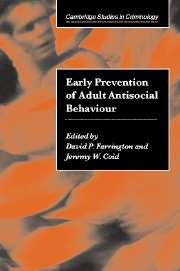Book contents
- Frontmatter
- Contents
- List of figures
- List of tables
- List of contributors
- Preface
- 1 Advancing knowledge about the early prevention of adult antisocial behaviour
- 2 Formulating strategies for the primary prevention of adult antisocial behaviour: “High risk” or ‘population’ strategies?
- 3 Risk factors for adult antisocial personality
- 4 Preventing the intergenerational continuity of antisocial behaviour: Implications of partner violence
- 5 Protective factors and resilience
- 6 Prevention during pregnancy, infancy and the preschool years
- 7 Prevention through family and parenting programmes
- 8 Prevention in the school years
- 9 Prevention of antisocial behaviour in females
- 10 Economic costs and benefits of primary prevention of delinquency and later offending: A review of the research
- 11 Conclusions and the way forward
- Index
- References
4 - Preventing the intergenerational continuity of antisocial behaviour: Implications of partner violence
Published online by Cambridge University Press: 22 September 2009
- Frontmatter
- Contents
- List of figures
- List of tables
- List of contributors
- Preface
- 1 Advancing knowledge about the early prevention of adult antisocial behaviour
- 2 Formulating strategies for the primary prevention of adult antisocial behaviour: “High risk” or ‘population’ strategies?
- 3 Risk factors for adult antisocial personality
- 4 Preventing the intergenerational continuity of antisocial behaviour: Implications of partner violence
- 5 Protective factors and resilience
- 6 Prevention during pregnancy, infancy and the preschool years
- 7 Prevention through family and parenting programmes
- 8 Prevention in the school years
- 9 Prevention of antisocial behaviour in females
- 10 Economic costs and benefits of primary prevention of delinquency and later offending: A review of the research
- 11 Conclusions and the way forward
- Index
- References
Summary
Antisocial behaviour is highly stable across the life course of individuals (Farrington, 1995; Loeber, 1982), and it runs strongly from generation to generation within families (Huesmann et al., 1984; Rowe and Farrington, 1997). Indeed, the correlation between measures of fathers' and sons' antisocial behaviour appears to be about as high as the correlation between measures of antisocial behaviour taken at two points in the life course of the same individual. Behavioural genetic studies reveal that less than half of this inter-generational continuity can be ascribed to heritable factors (Carey, 1994; Miles and Carey, 1997). Moreover, behavioural genetic studies estimate that environmental factors shared by family members must account for as much as one-third of the population variance in children's antisocial behaviour (averaged across six large-scale twin studies available when this chapter was written: Edelbrock et al., 1995; Eley, Lichtenstein and Stevenson, 1999; Gjone et al., 1996; Schmitz et al., 1995; Silberg et al., 1994; Thapar, 1995). The antisocial behaviour of almost all seriously antisocial adults first emerged during early childhood in the context of the family home (Moffitt, 1993; Moffitt, Caspi, Dickson, Silva and Stanton, 1996; Robins, 1978). When official crime records are searched for all of the mothers, fathers, sisters, and brothers in a large sample of families, over 50 per cent of the offences are concentrated in only 5 per cent of the families (Farrington, Barnes and Lambert, 1996).
- Type
- Chapter
- Information
- Early Prevention of Adult Antisocial Behaviour , pp. 109 - 129Publisher: Cambridge University PressPrint publication year: 2003
References
- 24
- Cited by



